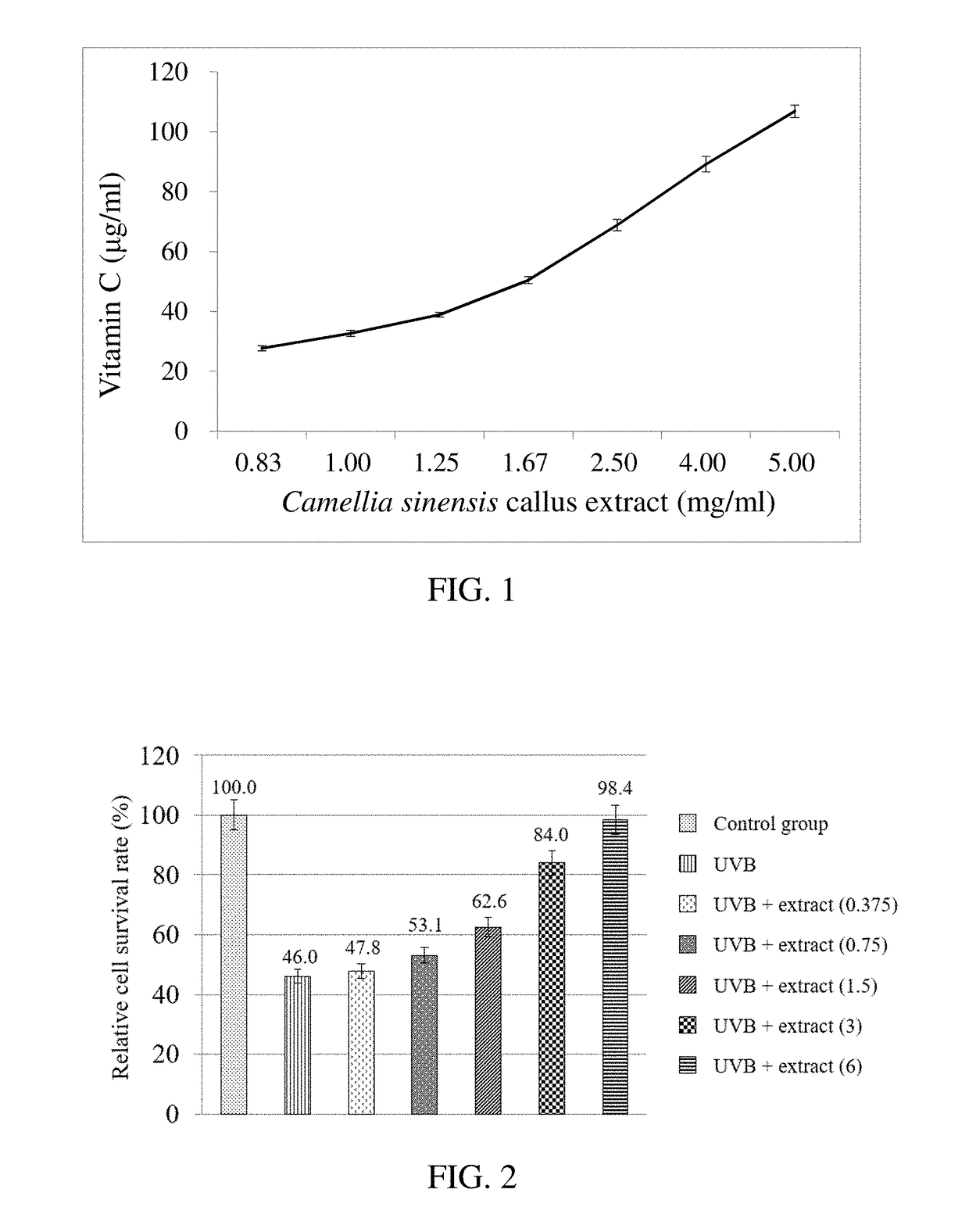Method for protecting skin by using camellia sinensis callus extract
a technology of camellia sinensis and callus, applied in the field of camellia sinensis callus extract in protecting skin, can solve the problems of skin aging, skin sagging and wrinkles, skin aging, etc., and achieve the effects of preventing skin lesions, promoting wound healing, and improving skin condition
- Summary
- Abstract
- Description
- Claims
- Application Information
AI Technical Summary
Benefits of technology
Problems solved by technology
Method used
Image
Examples
example 1
Preparation of Camellia Sinensis Callus Extract
[0042]The Camellia sinensis plants were purchased from Guoguang Flower Market (Taichung, Taiwan) and were subjected to the following operations to provide Camellia sinensis callus(es):[0043]I. Washing Camellia sinensis plants with 2% sodium hypochlorite solution then with sterile water, optionally, the aforementioned washing steps could be repeated;[0044]II. Cutting leaves of the washed Camellia sinensis plants to create wounds on their surfaces to induce the callus generation (for 1 to 3 months); and[0045]III. Cultivating the callus(es) obtained from step II in a ½MS medium (½×Murashige and Skoog Basal Medium, purchased from SIGMA company, product number: M5524) at a temperature of 25° C. and a humidity of 50˜60% (for 1 to 1.5 months).
[0046]The Camellia sinensis calluses obtained from step III were subjected to the following operations to prepare a Camellia sinensis callus extract:[0047](1) Freeze-drying the Camellia sinensis calluses ...
example 2
Effect of Camellia Sinensis Callus Extract on Anti-Oxidation
[0053]The Camellia sinensis callus extract dry matter obtained from step (6) of Example 1 was divided into seven groups, and then independently mixed with reverse osmosis (RO) water to prepare seven solutions whose concentrations of Camellia sinensis callus extract were 0.83, 1.00, 1.25, 1.67, 2.50, 4.00 and 5.00 mg / ml respectively. Thereafter, each of the Camellia sinensis callus extract solutions was subjected to the following treatments respectively:[0054]I. Mixing 2.5 ml of Camellia sinensis callus extract solution or 2.5 ml of standard with 2.5 ml of 0.2M phosphate-buffered saline (pH=6.6) and 2.5 ml of 1% potassium ferricyanide (PFC) to provide a mixed solution, and keeping the mixed solution at 50° C. for 20 minutes;[0055]II. Cooling the product of step I, mixing the product with 2.5 ml of trichloroacetic acid (TCA) evenly to provide a mixture, and then, centrifuging the mixture at 3000 g for 10 minutes and collectin...
example 3
Effects of Camellia Sinensis Callus Extract on Against Photodamage
[0060](3-1) MTT Assay
[0061]Human skin fibroblasts (CCD-966SK; purchased from ATCC) were cultivated in a MEM medium (Minimum Essential Medium; purchased from Gibco, product number: 61100-061) for 24 hours. Thereafter, human skin fibroblasts were divided into seven groups and were independently subjected to the following treatments:[0062]1. Control group: cells were cultivated in a MEM medium for 24 hours (i.e., the cells were cultivated in a medium free of Camellia sinensis callus extract).[0063]2. “UVB” group: cells were cultivated in a MEM medium for 24 hours (i.e., the cells were cultivated in a medium free of Camellia sinensis callus extract), and then were irradiated with UVB (15 J / cm2) for 1 hour.[0064]3. “UVB+extract (0.375)” group, “UVB+extract (0.75)” group, “UVB+extract (1.5)” group, “UVB+extract (3)” group, and “UVB+extract (6)” group: cells of each group were cultivated in a MEM medium being externally adde...
PUM
 Login to View More
Login to View More Abstract
Description
Claims
Application Information
 Login to View More
Login to View More - R&D
- Intellectual Property
- Life Sciences
- Materials
- Tech Scout
- Unparalleled Data Quality
- Higher Quality Content
- 60% Fewer Hallucinations
Browse by: Latest US Patents, China's latest patents, Technical Efficacy Thesaurus, Application Domain, Technology Topic, Popular Technical Reports.
© 2025 PatSnap. All rights reserved.Legal|Privacy policy|Modern Slavery Act Transparency Statement|Sitemap|About US| Contact US: help@patsnap.com



